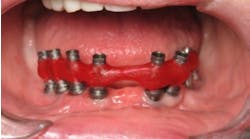Tips on how to improve your dental treatment consent form: A legal perspective
Any dentist in good standing understands the need for a valid informed consent. With information readily available to the patient and the ever-increasing patient’s oral health education, communication is in the forefront of risk management in patient care. Patients want more information regarding their treatment to make their own treatment decisions, thus keeping the patient’s autonomy strong and intact. One of the utmost functions of informed consent is the protection of the patient’s right to self-determination to accept or reject the treatment proposed. (1)
MORE LEGAL AND FINANCIAL-RELATED ARTICLES ...
Introduction to noncompetition and nonsolicitation agreements for dental professionals
3 common mistakes to avoid to succeed in dental case acceptance and collections
It is not imperative to inform the patient of every risk/benefit nuance of the procedure. Risks that are very rare or are of such general knowledge need not be disclosed. However, informed consent is patient- and treatment-specific. (2) Hence, what is told to the 20-year-old patient with good health regarding an extraction of a root-resorbed deciduous tooth and to the 70-year-old patient with extensive medical history, including blood thinners and bisphosphonates, regarding an extraction of a fractured root canaled mandibular second molar will and should be different. Each has different direct and foreseeable risks attached to the extraction procedure. Every patient is entitled to be informed of all directly related and reasonably foreseeable risks.
However, beware of the “patient set-ups” by which the patient wishes not to be informed. The “patient set-ups” will usually be something similar to:
“Whatever you say; you’re the doctor.”
“You are such a good dentist; I trust you to do what is right.”
“You don’t have to tell me; I’ve had this done before.”
“Just do the best you can; I trust you.” (3)
These should set off a “lightbulb” thought that an informed consent is definitely needed to make sure what the patient understands is correct and to substantiate legal scrutiny as truly being informed.
Informed consent has two aspects: the informed part and the consent part. Each of these has numerous elements to be fulfilled to have a valid informed consent.
The informed part consists of six parts that the dentist is responsible to provide for the patient to be properly and fully informed:
- The use of understandable terms and language when explaining the procedure
- Reasons or diagnosis prompting the planned procedure
- The benefits, anticipated outcome, and prognosis of the procedure
- Any reasonable and foreseeable risks that are attached to the procedure
- Reasonably feasible alternative treatment, including no treatment, and the accompanying risks and benefits
- The associated costs of the planned procedure and alternatives
I have added costs due to the fact that it is a determining factor for the reasonable person when deciding whether to consent (or not) to a particular dental treatment or its alternative. If a written document is being used, be aware not to simply make a “laundry list” of possible risks. If such a list is used, the words “but not limited to” should be inserted prior to the list of risks. This alerts the patient that other risks, though remote, may be possible. Also available are informed consent videos that fulfill most of the elements — after which, the patient should sign a form acknowledging they viewed and understood the video. A signed treatment plan or financial agreement is not an informed consent. They are separate and distinct from each other.
The consent part consists of eight elements to allow the consent to be valid:
- The consent must be freely given and voluntary.
- The patient must be given an opportunity to ask questions and have them answered competently and completely.
- To be informative and understandable, the information part as well as the consent part must be in a language the patient understands. If necessary, provide an interpreter or have the patient bring an interpreter with him or her to the dental appointment. If an interpreter is being used, record the name and relationship to the patient.
- The person giving the consent must be authorized to make such decisions.
- Consent must be obtained by the dentist or trained auxiliary personnel (per your jurisdiction).
- The dentist must be available to answer any patient questions.
- Some jurisdictions require the consent to be a signed written document for certain invasive procedures. It is highly advisable to obtain a written signed consent for any endodontic, surgical, or other invasive procedure.
- Consent must not be rushed or coerced. (4)
When a patient refuses treatment, it is highly advised to have the patient sign a written informed refusal indicating the patient’s full understanding of the risks associated with his or her refusal to recommended treatment. This includes the refusal not to seek specialty care when recommended. This prevents the patient from stating in a future alleged malpractice lawsuit that they were not informed of loss of teeth, or even death due to their refusal to treat.
Patient refusal of treatment
Just as important as informed consent is an informed refusal, which should be equally documented. All patients have the right to self-determination in accepting and rejecting proposed treatment. This is patient autonomy, which is the ethical sister to the legal concept of informed consent. Patient autonomy gives the patient or the patient’s guardian the right to self-determination as to the course of treatment the patient wants to allow. A patient cannot exercise that right if he or she is not given a proper informed consent. In the refusal of proposed treatment, an express written refusal of treatment document should be signed by the patient and entered into the patient’s record. The patient must be informed of all the risks and consequences (including medical ramifications and sequeale) of their decision not to follow the dentist’s recommendations or to discontinue treatment. The patient’s refusal to follow a referral to another health-care practitioner for needed treatment should also be regarded as a refusal of treatment.
Alongside treatment refusal is patient’s dictating treatment to the extent beyond the standard of care or to the level of self-injury, which are the limitations of patient autonomy. Due to the reality of patient finances, there is a temptation to attempt to satisfy the patient even though the practitioner does not feel professionally comfortable to provide such treatment. Not wanting to lose the patient, the practitioner may feel pressured into providing that requested treatment, though not ideal, but still within the standard of care. In such situations, a very thorough informed consent, preferably written, must be documented for risk management purposes. However, if the requested/dictated treatment would be considered below the standard of care, the provider should not oblige the patient.
There is also the question of referrals given to a patient for financial gain due to the relationship of the health-care practitioners. With more multispecialty practices coming into existence, there is a tendency of the intra-referral situation for financial gain. This can also be seen in the referral to a family member for financial reasons and not placing the patient’s best interest first. In both situations, the patient should be informed that the reason for the referral to a specific health-care provider is due to an existing relationship, whether financial or family related. The patient would then be fully informed of the reason, although needing treatment, for the particular referral was motivated by the relationship.
Informed consent intrusion
With so much information easily available on the Internet, patients often turn to their computers and the World Wide Web to seek additional information regarding their dental needs. Sometimes this information is not correct and may lead patients to think that the health-care provider did not fully inform them, not trust the information given, and/or maybe even second-guess the providers in their diagnoses and treatments. It may even lead patients to question what is in different materials that were used and the need for that particular material when the Internet suggested differently. With this unverified information patients now have, they may now question the informed consent given and the trust they may have had in their doctors. This intrusion of outside unverified information undermines the trusting doctor-patient relationship and the trust needed to have a valid informed consent. Health-care providers must be ready to discuss such intrusion in an honest and open manner.
References
1. Schloendorff v. Society of New York Hosp., 105 N.E. 92, 93 (N.Y. 1914).
2. Graskemper DDS JD, JP. Professional Responsibility in Dentistry: A Practical Guide to Law and Ethics,(Ames, Iowa: Wiley-Blackwell 2011), p. 52.
3. Ibid. p. 52.
4. Ibid. p. 54.








